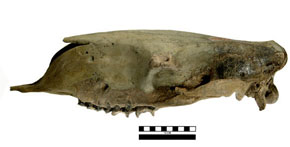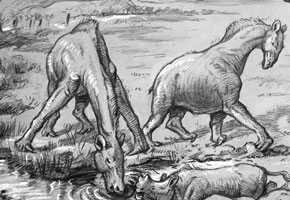Chalicotheriidae
Chalicotheriidae: The Chalicotheres are perhaps the most bizarre perissodactyls to have ever lived. While other perissodactyls possess hooves, Chalicotheres have secondarily evolved claws. Claws and hooves are both made from keratin (the same substance that your hair and fingernails are made of), which does not fossilize. However, we can tell whether animals were clawed or hoofed in the fossil record by the different shapes of their highly modified hand and foot bones. The bones at the end of chalicothere fingers and toes show that they were originally covered by keratinous claws. Like brontotheres, the origins of chalicotheres is shrouded in mystery. No one is certain exactly how they are related to other perissodactyls, although they retain features in their feet and dentition that indicate that they are perissodactyls, despite their unusual appearance.


Left: Skull of Moropuselatus (AMNH 14379) from Agate Springs Nebraska. Victoria Healy\AMNH. Right: Ventral view of skull of Moropuselatus (AMNH 14379) from Agate Springs Nebraska. Victoria Healy\AMNH.
Moropus is a well-known chalicothere from the early Miocene of North America. Its bodily proportions are similar to a living okapi (a kind of short-necked giraffe), with longer forelimbs than hindlimbs and a somewhat elongated neck. Tylocephalonyx, also from the Miocene of North America evolved a unique dome-like structure that may have functioned in low-impact butting during competition for mates. Chalicotherium is one of the most advanced chalicotheres. It was widespread throughout Europe, Asia, and Africa, had front limbs that were much longer than its hindlimbs, and may have browsed from trees in a manner similar to gorillas or giant sloths. Chalicotheres have been extinct in North America for close to 9 million years, although they actually persisted in the Old World into the early Pleistocene.


Left: Skeleton of the left forefoot (left: CMNH 1604) and left hindfoot (right, CMNH 1710) from the North American chalicothere Moropuselatus. From Osborn, 1907. Right: Skull of the dome-headed chalicothere Tylocephalonyx skinneri (UCMP 115867) from Fremont County, Wyoming. Marjory Coombs\AMNH.



